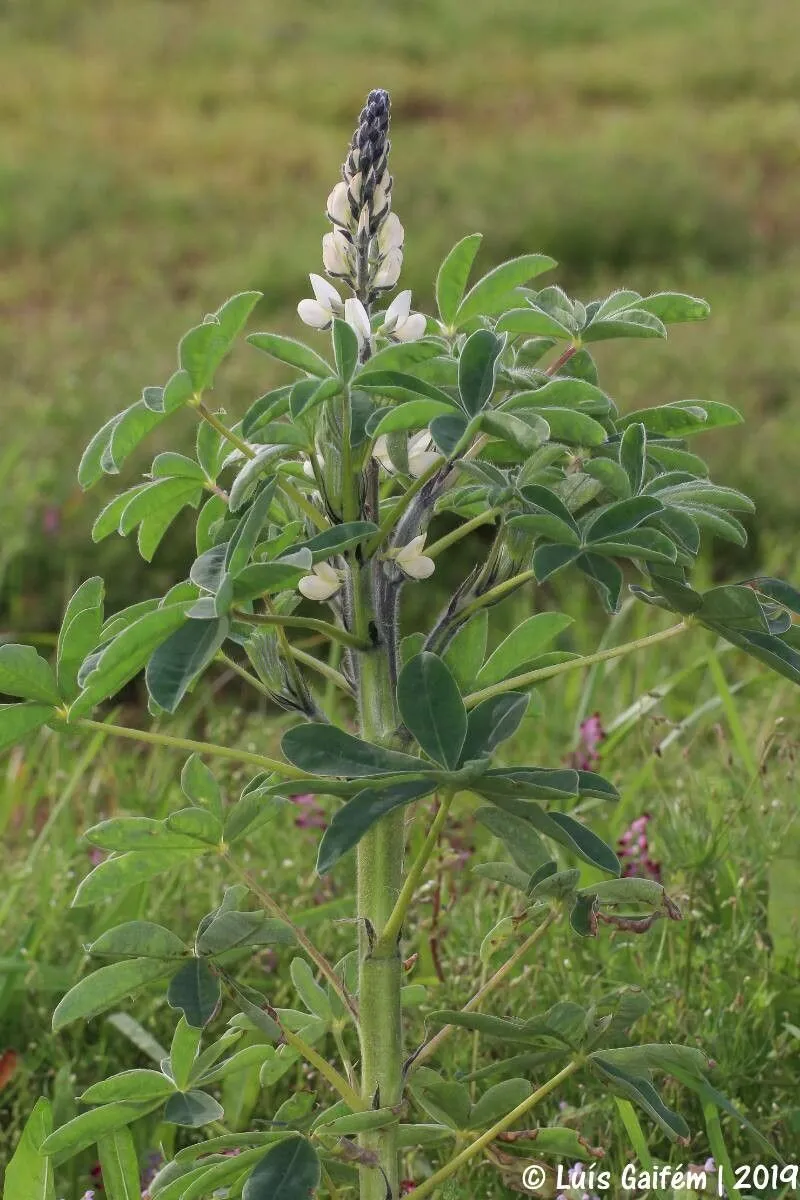
Author: L.
Bibliography: Sp. Pl.: 721 (1753)
Year: 1753
Status: accepted
Rank: species
Genus: Lupinus
Vegetable: False
Observations: SE. Europe to Türkiye
The Mediterranean white lupin, known scientifically as Lupinus albus, is a notable species within the Fabaceae family. Established in botanical nomenclature by the illustrious work “Species Plantarum” (Sp. Pl.) published in 1753 by the celebrated taxonomist Carl Linnaeus, this plant has a legacy that extends back centuries.
Native to the regions of Southeastern Europe and Turkey, the Mediterranean white lupin thrives in the diverse climatic and soil conditions of these areas. The species stands out not only for its geographical habits but also for its distinctive appearance and utility.
This perennial plant is easily recognized by its striking white flowers clustered in dense spikes, which bloom vibrantly, typically during the spring and early summer months. Its aesthetic appeal is complemented by its functional contributions to both natural ecosystems and agricultural practices.
In ecosystems, Lupinus albus plays a crucial role in nitrogen fixation, enriching the soil with essential nutrients and promoting the health of surrounding plant life. This natural process has made it an advantageous crop in sustainable farming, particularly in cropping systems that seek to minimize external chemical inputs.
Moreover, the seeds of the Mediterranean white lupin are a significant source of protein, making them a valuable ingredient in animal feed and, increasingly, in human diets as plant-based nutrition gains traction worldwide. The seeds are also renowned for their role in traditional dishes across the regions they are native to, highlighting their cultural as well as agricultural importance.
Through its journey from SE Europe to Türkiye, the Mediterranean white lupin stands as a testament to the intricate balance of beauty, utility, and adaptability in the plant kingdom. Its historical nomenclature, robust presence in its native habitat, and ongoing contributions to agriculture and ecology underscore its enduring significance in both natural and human-modified environments.
Eng: european white lupin, mediterranean white lupin, white lupin, white lupine
Dan: hvid lupin
Fra: lupin blanc, poi-loup
Heb: turmous lavan, תורמוס לבן
Deu: weiß-lupine, weiße lupine, weißs lupine
Spa: altramuz blanco, chocho blanco, lupino blanco
Hun: fehér csillagfürt
Ces: lupina bílá
Ita: lupino bianco
Por: lupino-branco, tremoçeiro-branco, tremoço, tremoço-branco
Swe: vitlupin
Nob: hvitlupin
Nno: kvitlupin
Cym: bysedd-y-blaidd gwyn
En: Mediterranean white lupin, European white lupin, White lupin, White lupine, Egyptian lupin, Egyptian Lupine, Lupine
Ar: ترمس ( تِرمس)
Cs: Lupina bílá
Da: Hvid lupin
Nl: Bittere Lupine, Witte Lupine
Fr: Lupin blanc, Poi-loup, Lupin d’Égypte, Lupin, Le Lupin
De: Weiße Lupine, Weiß-Lupine, Weißs lupine, Wolfsbohne, Weisse Lupine
He: Turmous lavan, תורמוס לבן, תורמוס תרבותי
Hu: Fehér csillagfürt
It: Lupino bianco
Nb: Hvitlupin
Nn: Kvitlupin
Pt: Tremoçeiro-branco, Lupino-branco, Tremoço, Tremoço-branco, Tremoceiro
Es: Altramuz blanco, Chocho blanco, Lupino blanco, Altramuz, Altramuz blanco amargo, Chocho, Lupino
Sv: Vitlupin
Cy: Bysedd-y-Blaidd Gwyn
Taken Apr 3, 2021 by Bonnet Kuari (cc-by-sa)
Taken Feb 23, 2019 by Gaifém Luís (cc-by-sa)
Taken Feb 21, 2021 by João Marques (cc-by-sa)
Taken May 1, 2022 by Adrian Domínguez (cc-by-sa)
Taken Mar 31, 2022 by Jamie Wood (cc-by-sa)
Taken May 4, 2022 by max desfrancois (cc-by-sa)
Taken Jun 4, 2020 by Mikyska Bohumil (cc-by-sa)
Taken Apr 17, 2022 by Ya Eric (cc-by-sa)
Taken Jan 9, 2022 by Torres Pedro (cc-by-sa)
Taken Feb 23, 2019 by Gaifém Luís (cc-by-sa)
Taken Nov 19, 2022 by Letícia Rigon (cc-by-sa)
Taken May 1, 2022 by Adrian Domínguez (cc-by-sa)
Taken Jan 11, 2021 by eleonora riso (cc-by-sa)
Taken Jun 2, 2021 by Steph85500 (cc-by-sa)
Taken Mar 16, 2022 by Enes Karasoy (cc-by-sa)
Taken Oct 7, 2021 by Wouter de Croon (cc-by-sa)
Taken Nov 14, 2022 by Nikolai Rupprecht (cc-by-sa)
Taken Jan 17, 2021 by Francisco Donoso (cc-by-sa)
Taken Jul 31, 2021 by Valerie Mason (cc-by-sa)
Taken Jul 7, 2022 by Hervé Rey (cc-by-sa)
Taken Feb 15, 2011 by Photoflora – Benoit BOCK (©)
Taken Apr 15, 2017 by Photoflora – Benoit BOCK (©)
Taken Feb 15, 2011 by Photoflora – Benoit BOCK (©)
Taken Jan 1, 1970 by Photoflora – L’Abbé COSTE (©)
Taken Jan 17, 2021 by Francisco Donoso (cc-by-sa)
Taken Apr 14, 2017 by Pedro Salgadinho (cc-by-sa)
Taken Oct 7, 2021 by Wouter de Croon (cc-by-sa)
Taken Jun 7, 2021 by Gianni Angeli (cc-by-sa)
Growth form: Single Crown
Growth habit: Forb/herb
Growth rate: Rapid
Ph maximum: 7.5
Ph minimum: 5.6
Light: 8
Atmospheric humidity: 5
Bloom months: [‘apr’, ‘may’, ‘jun’]
Soil nutriments: 7
Family: Myrtaceae Author: (F.Muell.) K.D.Hill & L.A.S.Johnson Bibliography: Telopea 6: 402 (1995) Year: 1995 Status:…
Family: Rubiaceae Author: Pierre ex A.Froehner Bibliography: Notizbl. Bot. Gart. Berlin-Dahlem 1: 237 (1897) Year:…
Family: Sapindaceae Author: Koidz. Bibliography: J. Coll. Sci. Imp. Univ. Tokyo 32(1): 38 (1911) Year:…
Family: Asteraceae Author: A.Gray Bibliography: Pacif. Railr. Rep.: 107 (1857) Year: 1857 Status: accepted Rank:…
Family: Fabaceae Author: Medik. Bibliography: Vorles. Churpfälz. Phys.-Ökon. Ges. 2: 398 (1787) Year: 1787 Status:…
Family: Aspleniaceae Author: (Cav.) Alston Bibliography: Bull. Misc. Inform. Kew 1932: 309 (1932) Year: 1932…